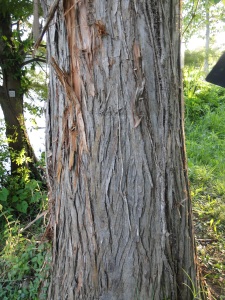Tolerant of many soil conditions, herbivores, and air pollution, Bald Cypress are fantastic street and city trees. They normally grow near on in standing bodies of water and, with their ability to create “knees” (root protrusions into the air), are one of the hardiest trees in their range. They are one of the major tree species occupying North American bogs, marshes, and “flotants”. Bald Cypress also grow quickly into large trees and persist for up to 1800 years.
Taxodium distichum (Bald Cypress)
Deciduous: yes
Hardiness Zones: 4-9
Height: 15-21 meters (50-70 feet) (sometimes up to 45 meters (150 feet)) tall
Diameter: 6-13 meters (20-45) feet across
Growth Rate: moderately fast (12-15 meters (40-50 feet) in 15-25 years)
Age: typically up to 600 years, potentially up to 1800 years old
Root System: surface roots typically not a problem, form “knees” in wet regions
Family: Cupressaceae
Subspecies: var. distichum, hybridizes with var. imbricarium (pond cypress), ‘Cascade Falls’ (dwarf, drooping foliage), ‘Peve Minaret’ (very small dwarf), var.
imbricarium ‘Nutans’, ‘Pendens’ (drooping foliage, horizontal branches), ‘Peve Yellow’ (dwarf, slow growing, yellow to yellow-green foliage), ‘Mickelson’/SHAWNEE BRAVE (mroe narrow and dense), ‘Monarch of Illinois’
Tolerates: clay/heavy soils, dry soils (once mature), very wet soils (extremely tolerant, arguably most tolerant tree to wet soils), urban air conditions (pollution), herbivores (deer), breaking of branches
Problems (major): chlorosis (in alkaline soils
Problems (minor): bagworms, spider mites, gall mites, twig blight
Poisonous: none known
Soil requirements: performs best in consistently moist, acidic (less than a pH of 7.5), light/sandy, somewhat well-drained soils that can retain water (tolerates most soil conditions)
Air requirements: tolerates pollution
Watering requirement: moderate to high (survives in swamps/marshes/near standing water), typically grow with a drier season
Sun requirement: full sun required
Needles: soft, minuscule, light green, to 1 centimeter (0.5 inches) long, turn orange/brown/copper in autumn, deciduous
Cones (male): smaller, more cylindrical than female cones
Cones (female): spherical, wrinkly, light green, maturing to brown, 2-3 centimeters (1 inch) in diameter
Seeds require stratification: yes
Monoecious or Dioecious: monoecious
Trunk: somewhat pyramidal, orange/brown, not perfectly rounded
Form: columnar to pyramidal, distinguished from Dawn Redwoods (Metasequoia glyptostroboides) by form when mature and horizontal branching (more upward, diagonal branching in M. glyptostroboides)
Notable characteristics:
Mature trees in or near standing water will often develop thick “knees” (root projections above water/ground) to obtain additional oxygen. The trunks are buttressed, and the wood has a distinctive look to it (brown to cinnamon colored). The crown forms a columnar to vaguely pyramidal shape.
Dendrology and differences from Dawn Redwoods (M. glyptostroboides):
- smaller leaves and (significantly smaller) leaflets (Pond Cypress have juniper-like, scale-like foliage)
- more columnar form (finely pyramidal in Dawn Redwoods), especially once mature
- fairly horizontal, slightly downward, or slightly upward branching (Dawn Redwoods have very distinctive upright diagonal branching to about 45 degrees)
- buttressed base less significant (extraordinarily prominent in Dawn Redwoods)
- female cones (spherical and light green to light brown in Bald and Pond Cypress, smaller and look very similar to Coast Redwood (Sequoia gigantea) in Dawn Redwoods)
- presence of knees in Bald (and Pond) Cypresses, entirely absent in Dawn Redwoods
- habitat (both require full sun, but Bald and Pond Cypresses thrive in marshes and much wetter areas than Dawn Redwoods).
Uses:
The wood is heavy and resists rotting, making it ideal for woodworking. Bald cypress are frequently used in the south as street trees or city trees.
Sources used:
- http://www.missouribotanicalgarden.org/PlantFinder/PlantFinderDetails.aspx?kempercode=m510
- http://www.missouribotanicalgarden.org/PlantFinder/PlantFinderDetails.aspx?kempercode=b439
- http://plants.usda.gov/core/profile?symbol=tadi2
- http://hort.ifas.ufl.edu/database/documents/pdf/tree_fact_sheets/taxdisa.pdf
- http://dendro.cnre.vt.edu/dendrology/syllabus/factsheet.cfm?ID=117
- http://plants.ces.ncsu.edu/plants/all/taxodium-distichum/
- http://www.pfaf.org/user/Plant.aspx?LatinName=Taxodium+distichum
- http://bigtree.cnre.vt.edu/TreeAge.htm
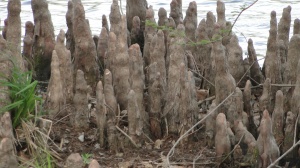
A large group of the root protrusions (“knees”)

Developing needles in Illinois
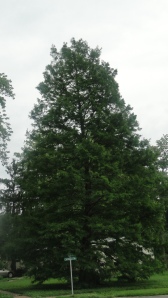
A fairly large T. distichum in Missouri
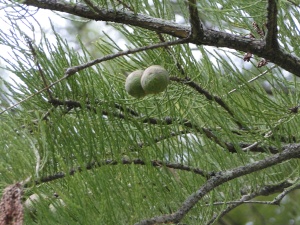
Foliage and female cones of Pond Cypress (siuc)
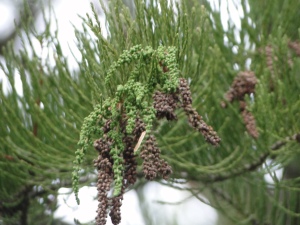
Pond cypress male cone cluster (siuc)

Juniper-like/scale-like foliage of Pond Cypress (siuc)
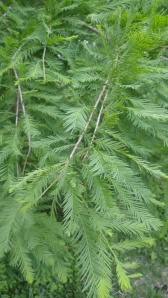
Foliage in Missouri
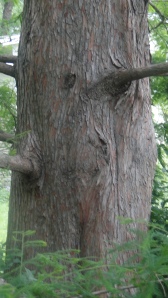
The brown-cinnamon colored trunk
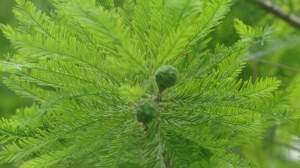
Light green, new foliage with new, immature, green cones
All of the images provided were taken by me. They may be used for educational/informational purposes only, provided that this article/online journal is appropriately cited first.


